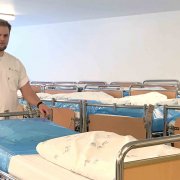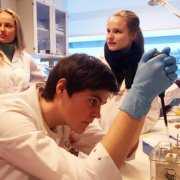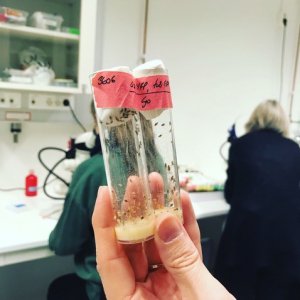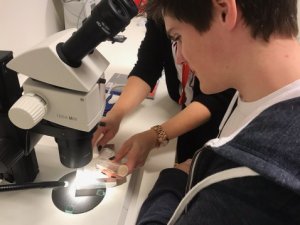Transporting patients
Student Jørgen Amdim got to experience life as an orderly on his one-week placement at the Norwegian Radium Hospital.
Transporting patients in Norway’s biggest cancer hospital is strenuous both physically and psychologically. “But it’s really good,” said Jørgen Amdim, who is studying the program Healthcare, childhood and youth development at Ullern Upper Secondary School. His one-week placement was at the Transport Section at the Norwegian Radium Hospital. The work experience certainly gave him a taste for more.
Jørgen has previously worked in a nursing home, but he found the work a little tedious. He enjoyed being an orderly though and asked the school if there were any available placements.
An orderly is an attendant in a hospital who is responsible for, among other things, transporting patients, medical equipment and other essential materials. Jørgen spent one week as an orderly at the Radium Hospital and he loved it. He enjoyed it so much that he wants to work there again during the summer of 2019.
Knut Arve Kristiansen, the Head of the Transport Section, has worked at the Radium Hospital for 30 years and praised Jørgen:
“He was a perfect addition to our team, and we are very happy with him.”
80 km per week
Jørgen enjoys manual labour, which is great if you want to become an orderly. Wheeling around heavy medical equipment or patients in beds and wheel chairs is hard work. Knut Arve explained:
”As orderlies, we’re constantly on the go, and we could end up walking around 80 kilometres on hard floors during a week of work.
“It can be strenuous for the body, so we have to regularly do strength exercises to keep fit,” Knut Arve continued.
Knut Arve only had positive things to say about Jørgen and he hopes that Jørgen will want to return to the Transport Section for a summer job as an orderly.
“Jørgen is a social person and very well liked. This is important for patients when they are transported between examinations and the rooms they are staying in,” said Knut Arve.
Jørgen praises the work environment and especially the warm welcome he received from the other staff.
Jørgen has constantly been accompanied by a colleague from the section during his stay, because he is not allowed to do much on his own when on a placement. If he returns for a summer job, things will be different. Then he will have to work more independently and take responsibility if an emergency should occur while he is transporting a patient.
The orderlies are also responsible for transporting food and medication. To newcomers, the Radium Hospital can appear to be a huge labyrinth, especially outside the wards. The hospital is also currently being renovated, because a new hospital is being built. A sense of direction is therefore essential for anyone finding their way through the building.
A future in health
Jørgen does not necessarily want to become an orderly, but sees himself working in healthcare:
“I would really like to work in an emergency room – receiving ill and injured people at the hospital when they arrive in an ambulance. But I think working as an orderly is very exciting too, so I don’t want to exclude it as an option.”
Knut Arve says that a trade certificate is required to work as an orderly and that they currently offer placements for several apprentices in the section. Students need to study Healthcare, childhood and youth development during upper secondary school and then finish a two-year apprenticeship to obtain their trade certificate as an orderly.
”Workdays here are very varied and you meet many different people. It is really fun to talk to people and no two days are the same. I have really enjoyed it.” said Jørgen.
Attracting and developing the life science talents of the future is an essential goal for Oslo Cancer Cluster. One way to do that is to take students outside the traditional classroom setting and invite them to work placements and educational lectures. These collaborations between industry and academia give the students a unique insight into the specialist skills needed to become tomorrow’s researchers and entrepreneurs.
- Find out more about Oslo Cancer Cluster’s school collaboration with Ullern Upper Secondary School.













